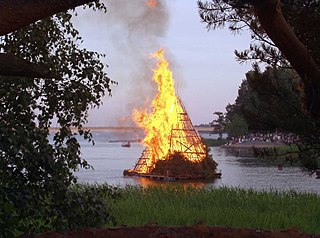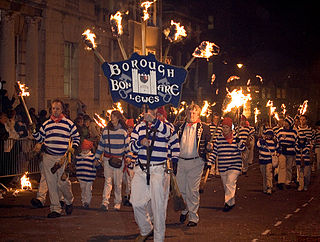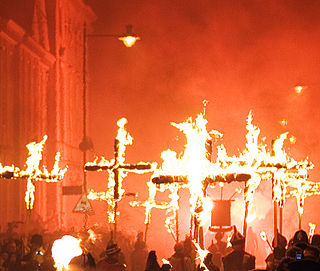
Beltane or Bealtaine is the Gaelic May Day festival, marking the beginning of summer. It is traditionally held on 1 May, or about midway between the spring equinox and summer solstice. Historically, it was widely observed in Ireland, Scotland, and the Isle of Man. In Irish the name for the festival day is Lá Bealtaine while the month of May is Mí na Bealtaine, in Scottish Gaelic Latha Bealltainn, and in Manx Gaelic Laa Boaltinn/Boaldyn. Beltane is one of the four main Celtic seasonal festivals—along with Samhain, Imbolc, and Lughnasadh—and is similar to the Welsh Calan Mai.

May Day is a European festival of ancient origins marking the beginning of summer, usually celebrated on 1 May, around halfway between the spring equinox and summer solstice. Festivities may also be held the night before, known as May Eve. Traditions often include gathering wildflowers and green branches, weaving floral garlands, crowning a May Queen, and setting up a Maypole, May Tree or May Bush, around which people dance. Bonfires are also part of the festival in some regions. Regional varieties and related traditions include Walpurgis Night in central and northern Europe, the Gaelic festival Beltane, the Welsh festival Calan Mai, and May devotions to the Blessed Virgin Mary. It has also been associated with the ancient Roman festival Floralia.

Samhain, Sauin or Oíche Shamhna is a Gaelic festival on 1 November marking the end of the harvest season and beginning of winter or "darker half" of the year. It is also the Irish language name for November. Celebrations begin on the evening of 31 October, since the Celtic day began and ended at sunset. This is about halfway between the autumnal equinox and winter solstice. It is one of the four Gaelic seasonal festivals along with Imbolc, Bealtaine, and Lughnasa. Historically it was widely observed throughout Ireland, Scotland, and the Isle of Man. A similar festival is held by the Brittonic Celtic people, called Calan Gaeaf in Wales.

Carnival or Shrovetide is a Christian festive season that occurs before Lent, consisting of Quinquagesima or Shrove Sunday, Shrove Monday, and Shrove Tuesday or Mardi Gras.

The Fallas is a traditional celebration held annually in commemoration of Saint Joseph in the city of Valencia, Spain. The five main days celebrated are from 15 to 19 March, while the Mascletà, a pyrotechnic spectacle of firecracker detonation and fireworks display, takes place every day from 1 to 19 March. The term Fallas refers to both the celebration and the Falla monuments burnt during the celebration. A number of towns in the Valencian Community have similar celebrations inspired by the original Fallas de Valencia celebration. For example, the bonfires of Alicante or the Fiestas de la Magdalena in Castellón de la Plana. The Fallas festival was added to UNESCO's intangible cultural heritage of humanity list on 30 November 2016.

A bonfire is a large and controlled outdoor fire, used either for informal disposal of burnable waste material or as part of a celebration.

Midsummer is a celebration of the season of summer occurring near the date of the summer solstice which is known in solar reckoning as the mid-point of the season. As the precise date of the summer solstice can vary from year to year, different traditions may celebrate or fix Midsummer at different dates or under different names occurring on or around the actual solstice. A variety of traditions have developed often rooted in regional, spiritual, or religious practices. Traditionally, Midsummer is on the first Saturday after June 20th, though it is often celebrated on Midsummer's Eve, on the day before.

Saint John's Eve, starting at sunset on 23 June, is the eve of the feast day of Saint John the Baptist. This is one of the very few feast days marking a saint's birth, rather than their death. The Gospel of Luke states that John was born six months before Jesus; therefore, the feast of John the Baptist was fixed on 24 June, six months before Christmas. In the Roman calendar, 24 June was the date of the summer solstice, and Saint John's Eve is closely associated with Midsummer festivities in Europe. Traditions are similar to those of May Day and include bonfires, feasting, processions, church services, and gathering wild plants.

Guy Fawkes Night, also known as Guy Fawkes Day, Bonfire Night and Fireworks Night, is an annual commemoration observed on 5 November, primarily in Great Britain, involving bonfires and fireworks displays. Its history begins with the events of 5 November 1605 O.S., when Guy Fawkes, a member of the Gunpowder Plot, was arrested while guarding explosives the plotters had placed beneath the House of Lords. The Catholic plotters had intended to assassinate Protestant king James I and his parliament. Celebrating that the king had survived, people lit bonfires around London. Months later, the Observance of 5th November Act mandated an annual public day of thanksgiving for the plot's failure.

Busto Arsizio is a comune (municipality) in the south-easternmost part of the province of Varese, in the Italian region of Lombardy, 35 kilometres (22 mi) north of Milan. The economy of Busto Arsizio is mainly based on industry and commerce. It is the fifth municipality in the region by population and the first in the province.

Lohri is a popular winter Dogra and Punjabi folk festival celebrated primarily in Northern India. The significance and legends about the Lohri festival are many and these link the festival to the Duggar region and Punjab region. It is believed by many that the festival marks the passing of the winter solstice. Lohri marks the end of winter, and is a traditional welcome of longer days and the sun's journey to the Northern Hemisphere. It is observed the night before Maghi.

The Sussex Bonfire Societies are responsible for the series of bonfire festivals concentrated on central and eastern Sussex, with further festivals in parts of Surrey and Kent from September to November each year.

Golowan is the Cornish language word for the Midsummer celebrations in Cornwall, UK; widespread prior to the late 19th century and most popular in the Penwith area and in particular Penzance and Newlyn. The celebrations were centred on the lighting of bonfires and fireworks and the performance of associated rituals. The midsummer bonfire ceremonies were revived at St Ives in 1929 by the Old Cornwall Society and since then spread to other societies across Cornwall, as far as Kit Hill near Callington. Since 1991 the Golowan festival in Penzance has revived many of these ancient customs and has grown to become a major arts and culture festival; its central event Mazey Day now attracts tens of thousands of people to the Penzance area in late June.
In Scottish, Northern English, and Manx folklore, the first-foot is the first person to enter the home of a household on New Year's Day and is seen as a bringer of good fortune for the coming year. Similar practices are also found in Greek, Vietnamese, and Georgian new year traditions.

Apotropaic magic or protective magic is a type of magic intended to turn away harm or evil influences, as in deflecting misfortune or averting the evil eye. Apotropaic observances may also be practiced out of superstition or out of tradition, as in good luck charms, amulets, or gestures such as crossed fingers or knocking on wood. Many different objects and charms were used for protection throughout history.

Hornachos is a municipality located in the province of Badajoz, Extremadura, Spain. According to the 2005 census (INE), the municipality has a population of 3,840 inhabitants.

Holika Dahan, rendered Holika Dahanam in Sanskrit or Chotti Holi, is a Hindu festival in which a bonfire is lit to celebrate the burning of the demoness, Holika. This ritual is symbolic of victory of good over evil. It precedes Holi, the festival of colours, which celebrates the spring season. According to legend, Holika was the sister of Hiranyakashipu, who acquired a boon that rendered her invulnerable to fire. She then attempted to kill her nephew, Prahlada, by placing him on her lap in a bonfire. However, she was immolated while Prahlada was saved from the fire.

Lewes Bonfire, or Bonfire for short, describes a set of celebrations held in the town of Lewes, Sussex, England, that constitute the United Kingdom's largest and most famous Bonfire Night festivities, with Lewes being called the bonfire capital of the world.

Pope Night was an anti-Catholic holiday celebrated annually on November 5 in the colonial United States. It evolved from the British Guy Fawkes Night, which commemorates the failure of the Gunpowder Plot of 1605. Pope Night was most popular in the seaport towns of New England, especially in Boston, where it was an occasion for drinking, rioting, and anti-elite protest by the working class.

Czech folklore is the folk tradition which has developed among the Czech people over a number of centuries. Czech folklore was influenced by a mix of Christian and pagan customs. Nowadays it is preserved and kept alive by various folklore ensembles uniting members of all ages, from children to seniors, showing their talent during competitions, folklore festivals or other performances.




















